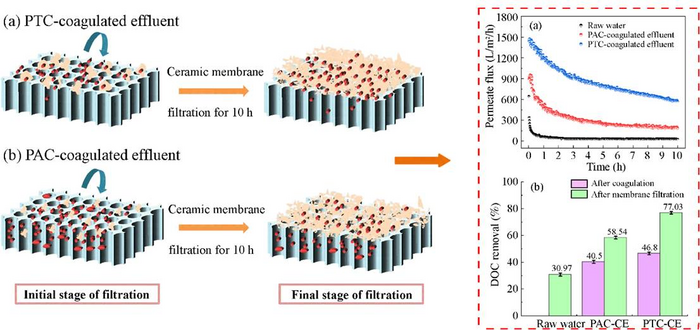Reviewed by Mila PereraSep 9 2022
Membrane technology is frequently used to treat dirty water to remove suspended particles, colloids, and organic contaminants. The ceramic membrane, a classic example of an inorganic membrane with excellent features such as high flux and chemical resistance, is potentially extremely useful in treating surface water, sewage from cities, and drinking water.

Image Credit: Xiaoman Liu, Chang Tian, Yanxia Zhao, Weiying Xu, Dehua Dong, Kaimin Shih, Tao Yan, Wen Song
Membrane fouling, however, is a major problem for the advancement and development of membrane processes. This problem is prevalent in many membrane processes, particularly that of pressure-driven wastewater filtering. Ceramic membrane is hence constrained. Therefore, the water treatment process urgently needs an efficient pretreatment method to lower membrane fouling.
As a result of its outstanding performance, low cost, and capacity to eliminate natural organic matter (NOM), coagulation is one of the most effective methods. The most popular coagulants currently are Al- and Fe-based salts due to their outstanding cost-efficiency and coagulation capabilities.
Despite this, Al- and Fe-based salts' biological toxicity and effluent coloration, respectively, limit their use. Due to their safety, superior performance, and ability to recycle sludge, titanium-based coagulants, a sophisticated method, have gained considerable attention recently. To accomplish effective and secure water purification, it is anticipated that it will be employed as a new generation coagulant to replace Al- and Fe-based coagulants.
Scientists from the University of Jinan, Qilu University of Technology (Shandong Academy of Sciences), and the University of Hong Kong assessed the pre-coagulation performance of titanium-based coagulants based on the case of emerging titanium-based coagulant (polytitanium chloride, PTC), which was contrasted with traditional Al-based coagulant (polyaluminum chloride, PAC).
They used four different mathematical models to synthetically investigate the fouling mechanisms. The study was published in the Frontiers of Environmental Science & Engineering journal.
The research team discovered in this investigation that the newly developed titanium-based coagulant improved the filtration performance of ceramic membranes. In comparison to PAC, the PTC demonstrated a sizable advantage that led to an increase in organic matter removal of nearly 20%.
Following PTC-coagulation, ceramic membrane filtering of the effluent generated a filtrate with increased quality (approximately 78.0% DOC removal) and a high flux of around 600 L/(m2·h).
With a low filtration flux of just 60 L/(m2·h), the PVDF membrane filtration could achieve a comparable level of DOC removal (around 77.0%). The fouling mechanisms of ceramic membranes were simulated using four mathematical models.
The primary fouling process in the PTC example was cake filtration, which was revealed by the use of the classic Hermia’s model. By contrast, the main fouling mechanism in the PAC scenario was standard filtration/intermediate filtration (blocking of membrane pores).
Additionally, Visvanathan and Ben aïm’s reports on the standard law filtration and traditional cake filtration models were unsuitable for characterizing fouling on ceramic membranes since they did not include R2 values for all possible scenarios. A segmented simulation was necessary to discern the different fouling mechanisms between the PTC and PAC situations using the linear classical Hermia’s model.
This research examined how PTC pre-coagulation improved the cross-flow performance of ceramic membranes. It was discovered that the PTC pre-coagulation could significantly improve ceramic membrane filtration performance and efficiently regulate ceramic membrane fouling.
Ceramic membrane filtration demonstrated good performance for the treatment of surface water. This research offers an efficient pretreatment method to improve water treatment filtration performance and sheds light on the research and testing of sophisticated precoagulation methods to prevent membrane fouling.
Journal Reference:
Liu, X., et al. (2022) Enhanced cross-flow filtration with flat-sheet ceramic membranes by titanium-based coagulation for membrane fouling control. Frontiers of Environmental Science & Engineering. doi.org/10.1007/s11783-022-1531-x.